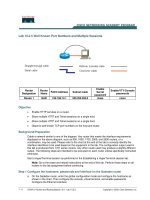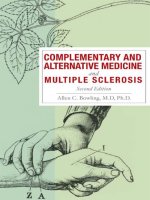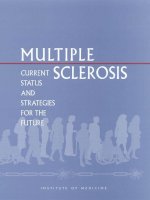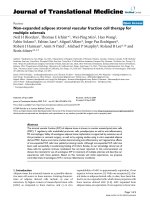Yoga and multiple sclerosis
Bạn đang xem bản rút gọn của tài liệu. Xem và tải ngay bản đầy đủ của tài liệu tại đây (10.81 MB, 293 trang )
Free ebooks ==> www.ebook777.com
www.ebook777.com
Free ebooks ==> www.ebook777.com
Yoga and Multiple Sclerosis
Free ebooks ==> www.ebook777.com
Yoga and
www.ebook777.com
Free ebooks ==> www.ebook777.com
Multiple Sclerosis
A Journey to
Health and Healing
Loren M. Fishman, M.D.
Eric L. Small
Free ebooks ==> www.ebook777.com
Special discounts on bulk quantities of Demos Medical Publishing books
are available to corporations, professional associations, pharmaceutical companies,
health care organizations, and other qualifying groups. For details, please contact:
Special Sales Department
DEMOS MEDICAL PUBLISHING
386 Park Avenue South, Suite 301
New York, NY 10016
Phone: 800-532-8663, 212-683-0072
Fax: 212-683-0118
Email:
8
Visit our website at www.demosmedpub.com
© 2007 by Demos Medical Publishing, LLC. All rights reserved.
This book is protected by copyright. No part of it may be reproduced,
stored in a retrieval system, or transmitted in any form or by any means,
electronic, mechanical, photocopying, recording, or otherwise,
without the prior written permission of the publisher.
L I BR ARY O F CO NGR E SS C ATA LOGIN G- IN - PUBLIC AT ION DATA
Fishman, Loren M.
Yoga and multiple sclerosis : a journey to health and healing / Loren
M. Fishman, Eric L. Small.
p. ; cm.
Includes bibliographical references and index.
ISBN-13: 978-1-932603-17-0 (pbk. : alk. paper)
ISBN-10: 1-932603-17-4 (pbk. : alk. paper)
1. Multiple sclerosis—Patients—Rehabilitation. 2. Yoga—Therapeutic
use.
I. Small, Eric L.
II. Title.
[DNLM: 1. Multiple Sclerosis—rehabilitation.
F537y
2. Yoga. WL 360
2007]
RC377.F57
2007
616.8’34062—dc22
2006030464
Designed by Steven Pisano
MANUFACTUR E D I N T HE UN IT ED S TAT ES OF A M ERIC A
07 08 09 10 11 5 4 3 2 1
www.ebook777.com
Free ebooks ==> www.ebook777.com
Dedication
Mr. Iyengar has led the quest for the authentic yoga of
antiquity no less than for its refinement and adaptation
to current times and the needs of living people. As a
teacher and researcher, a creative and disciplined leader,
a conceptual inventor and a physical presence in classes
and out, he is our master. To express our intellectual
debt and heartfelt gratitude to Mr. Iyengar, language
fails. But it is easy to state that the authors are fully
responsible for everything in this book.
Free ebooks ==> www.ebook777.com
www.ebook777.com
Free ebooks ==> www.ebook777.com
Contents
Preface xiii
PART I
YO GA FOR PEOPLE W IT H
MULTIPLE S CL EROS I S
Introduction
2
C H A PT E R 1. Restorative Series
Props 4
Savasana (Reclined Pose) 4
Dandasana (Supported Bridge Pose) 8
Supta Baddha Konasana (Supine Bound Angle Pose) 11
Viparita Karani (Supported Inversion Pose) 13
vii
Free ebooks ==> www.ebook777.com
CONTENTS
C H A PT E R 2.
Wheelchair Series
Wheelchair Urdhva Hastasana (Upward Hand Pose) 17
Virabhadrasana II (Warrior Pose II) 19
Parivrtta Virabhadrasana (Wheelchair Lateral Twist) 19
Wheelchair Adho Mukha Svanasana (Downward-Facing Dog Pose) 21
Wheelchair Parsva Adho Mukha Svanasana (Sideward Downward-Facing Dog Pose) 22
Wheelchair Adho Mukha Svanasana at Wall (Downward-Facing Dog Pose at Wall) 22
Wheelchair Surya Namaskar (Sun Salutation) 23
Wheelchair Virabhadrasana 1 (Warrior Pose I) 29
Wheelchair Utthita Trikonasana I (Extended Triangle Pose I) 30
Wheelchair Utthita Trikonasana II (Extended Triangle Pose II) 31
Viparita Dandasana (Wheelchair Backbend) 32
Wheelchair Marichyasana III (Wheelchair Seated Twists) 33
Wheelchair Pasasana (Wheelchair Twist with Bolster) 35
Wheelchair Baddha Konasana (Cobbler’s Pose) 36
Wheelchair Preparation for Janu Sirsasana (Preparation for Head-to-the-Knee Pose) 37
Wheelchair Janu Sirsasana (Head-to-the-Knee Pose) 38
Wheelchair Upavistha Konasana (Seated Wide Angle Pose) 39
Wheelchair Uttanasana (Forward Bend Pose) 40
Wheelchair Ardha Navasana (Supported Boat Pose) 41
Wheelchair Savasana (Relaxation Pose) 42
C H A PT E R 3.
Cha ir Seri es
Chair Urdhva Hastasana (Arms-Above-the-Head Pose) 43
Chair Uttanasana (Forward Bend Pose) 45
Chair Adho Mukha Svanasana (Downward-Facing Dog Pose) 47
Chair Parsva Adho Virasana (Downward-Angled Hero Pose) 47
Chair Adho Mukha Svanasana at Wall (Downward-Facing Dog Pose)
Chair Surya Namaskar (Sun Salutation) 49
Virabhadrasana II (Warrior Pose II) 54
Chair Virabhadrasana 1 (Warrior Pose I) 54
Chair Utthita Trikonasana (Extended Triangle Pose) 56
viii
www.ebook777.com
48
Free ebooks ==> www.ebook777.com
CONTENTS
Viparita Dandasana (Chair Backbend) 58
Seated Urdhva Dhanurasana (Pose II) 60
Seated Jathara Parivartanasana (Chair Lateral Twist)
C HAP T ER 4.
63
Seated Poses
Marichyasana III (Twisting Seated Pose) 65
Pasasana Variation (Chair Twist with Bolster) 67
Malasana Variation (Seated Chair Twist Without Bolster) 69
Chair Baddha Konasana (Cobbler’s Pose) 70
Chair Preparation for Janu Sirsasana (Head-to-the-Knee Pose) 72
Chair Janu Sirsasana 73
Chair Upavistha Konasana (Seated Wide-Angle Pose) 75
Chair Uttanasana (Forward Bend Pose) 76
Chair Ardha Navasana (Supported Boat Pose) 79
Chair Savasana (Relaxation Pose) 79
C H A PT E R 5. Seated/Floor Series
Supta Padangusthasana (Reclining Big-Toe Pose) 81
Dandasana (Staff Pose) 83
Paschimottanasana (Seated Forward Bend Pose) 84
Seated Baddha Konasana (Bound-Angle Pose) 84
Adho Mukha Baddha Konasana (Downward Bound-Angle Pose)
Janu Sirsasana (Head-to-the-Knee Pose) 86
Supported Sarvagasana (Shoulder Stand) 89
Marichyasana Variation (Grandfather of the Sun Pose) 96
C H A PT E R 6. Pranayama
A Brief Explanation 99
Prone Position 102
Smooth Breath 105
86
and Relaxation
ix
Free ebooks ==> www.ebook777.com
CONTENTS
Ujjayi 105
Viloma One 106
Viloma Two 107
Viloma Three 107
Floor Savasana 108
PART
II
F unc tion-Directed Yoga for
F unc tional ly Im pai r e d Indi vi duals
Introduction 112
How Yoga Applies 113
Promotion and Prevention 115
Different Uses of Yoga in Relapsing and Progressive MS 115
Motivation, Feedback, and Miracles 116
The Invisible Treatment 118
Tadasana (The Mountain) 120
Dandasana (The Staff) 121
Savasana (Corpse Pose) 122
Specifically Directed Poses 123
C HAP T ER 7. Reduce Fatigue
Vitari Karani 127
Ustrasana (The Camel) 130
Bhujangasana (The Serpent) 135
Urdhva Dhanurasana I (The High Bridge) 136
Padmasana (The Lotus) 140
x
www.ebook777.com
Free ebooks ==> www.ebook777.com
CONTENTS
C H A PT E R 8.
Improve Range of Motion
Strategies to Improve Range of Motion 148
Trikonasana 148
Virasana 152
Supta Virasana (Supine Hero’s Pose) 155
Parighasana (Country Gate Pose) 159
Triang Mukhaikapada Paschimottanasana (Three Limbs to the West Pose)
C H A PT E R 9. Spasticit y
The Stretch Reflex 166
Feed Forward from Reducing Spasticity to Improving Range of Motion
The Agonist-Antagonist Reflex 168
Janusirsasana (Head-to-the -Knee Pose) 169
Paschimottanasana (West Pose) 173
Parvatasana (Daughter of the Himalayas) 177
Marichyasana III 179
Upavista Konasana (Seated Angle Pose) 183
Baddha Konasana (Bound Angle Pose) 186
Parsvottanasana (Intense Flank Stretch) 187
162
167
C H A PT E R 10. Streng th
Strengthening 191
Navasana (The Boat) 193
Utthita and Parivritta Parsvakonasana (Extended and Revolving Lateral Angel Pose)
Virabhadrasana I, III (The Warrior Poses) 206
C H A PT E R 11. Co ordination and
Coordination 214
Bhujapidasana (Shoulder Pressure Pose) 214
Sarvangasana/Halasana (Shoulder Stand / The Plow) 218
196
Balance
xi
Free ebooks ==> www.ebook777.com
CONTENTS
C H A PT E R 8.
Improve Range of Motion
Strategies to Improve Range of Motion 148
Trikonasana 148
Virasana 152
Supta Virasana (Supine Hero’s Pose) 155
Parighasana (Country Gate Pose) 159
Triang Mukhaikapada Paschimottanasana (Three Limbs to the West Pose)
C H A PT E R 9. Spasticit y
The Stretch Reflex 166
Feed Forward from Reducing Spasticity to Improving Range of Motion
The Agonist-Antagonist Reflex 168
Janusirsasana (Head-to-the -Knee Pose) 169
Paschimottanasana (West Pose) 173
Parvatasana (Daughter of the Himalayas) 177
Marichyasana III 179
Upavista Konasana (Seated Angle Pose) 183
Baddha Konasana (Bound Angle Pose) 186
Parsvottanasana (Intense Flank Stretch) 187
162
167
C H A PT E R 10. Streng th
Strengthening 191
Navasana (The Boat) 193
Utthita and Parivritta Parsvakonasana (Extended and Revolving Lateral Angel Pose)
Virabhadrasana I, III (The Warrior Poses) 206
C H A PT E R 11. Co ordination and
Coordination 214
Bhujapidasana (Shoulder Pressure Pose) 214
Sarvangasana/Halasana (Shoulder Stand / The Plow) 218
196
Balance
xi
www.ebook777.com
Free ebooks ==> www.ebook777.com
CONTENTS
Svanasana (Dog Poses) 222
Urdhva Mukha Svanasana (Upward Facing Dog) 222
The Wall Dog (A Standing Intermediate for Both Dog Poses)
Jathara Parivartanasana (Abdominal Turning Pose) 227
Sirsasana Headstand 230
C H A PT E R 12.
226
Confidence and Calm
2 37
C H A PT E R 13. Adva nce d Bal an c e
Vrksasana (The Tree) 240
Ardha Chandrasana (Half-Moon Pose) 243
Eye-Closed Tadasana (The Closed Eyes Mountain) 247
Pasasana (The Basket) 251
Vasisthasana 254
C H A PT E R 14.
Breathin g
2 57
Afterword
Notes
264
Index 267
xii
259
Free ebooks ==> www.ebook777.com
Preface
I
t is paradoxical that yoga, thousands
of years old and originating in India, a
warm country where multiple sclerosis is almost nonexistent, is both utterly contemporary and of great benefit in the treatment of
multiple sclerosis (MS). Fatigued by modern
medicine’s sharp compartmentalization, contemporary medicine has rebelled and claims
interest in the whole person. Yoga and its
goals have always addressed the whole person;
there is no such thing as “yoga of the thigh.”
But there are also distinct differences between medicine and yoga. With the exception
of public health, medicine is only brought in
when things go wrong, and only until the status quo has been reached again. Yoga, always
concerned with the individual, takes up for
no reason at any stage along the continuum
of health and disease, and does not relinquish
its hold when illness does. On the contrary, it
continues to take practitioners beyond mere
absence of disease toward a goal of wisdom
and peace.
Yoga is not science. The constellation of
physics, chemistry, and biology, from which
medicine is an offspring, gathers data empirically and uses logical methods of proof.
Empirical and deductive means combine to
determine the diagnoses and progress of individuals. If yoga is to be rationally valued, it
must be evaluated in terms of the sciences: it
will not do anyone any good to conclude that
xiii
www.ebook777.com
Free ebooks ==> www.ebook777.com
PREFACE
yoga is beneficial in MS because more people
learn to do the shoulder stand. They must be
shown to ambulate more safely, have better
visual evoked potentials, or score better on
the Kurtzke Scale. Science’s services are then
needed again to explain how yoga works.
Yoga is changing along with the global
culture of which it forms a part. While yoga
has been passed on from teacher or guru to
individual student for all of its many generations, today’s mobile societies require a certification program to distinguish the serious
practitioner from other types. There are a
large number of written texts, movies, tapes,
videos, and web sites, but it is part of the credo of yoga that it actually be taught.
The precious gift that Mr. B. K. S. Iyengar has given us, in the form of his work and
the distinguished striving his life represents,
has enabled large numbers of people to avail
themselves of a very refined and detailed
teaching that would not have been possible
using the old-time methods. Many quotes,
techniques, and almost all the poses in this
book derive from his books and teaching.
In this context, this book is offered as a
guide and helpmate to those who would use
yoga, be they physicians, physical therapists,
nurses, parents, children, students or, perchance, teachers.
The book is divided into two sections: the
first is a straightforward but gentle introduction to yoga for people with significant MS involvement. It is a therapeutic approach to the
practice itself. Without this, the rest of the
book might be just an academic exercise.
The second part is functionally oriented:
different yoga poses are assembled that work
xiv
toward a common goal, such as combating
fatigue, reducing spasticity, and increasing
range of motion. It is intended for people
with MS and other neurological conditions,
people who undertake yoga on their own,
and for members of the medical and yoga
communities. It begins with a more detailed
analysis of how yoga appears to work: describing basic physiological means by which
it helps people with MS and similarly affected patients. It then sorts out which poses are
helpful for which conditions, and it guides
teachers, students, and patients on how to
use the physiological considerations to adapt
the poses to individual patients’ needs. It
is intended for people that have or readily
could have completed Part I.
Yoga was begun thousands of years ago as
the science of quieting the mind. Patanjali, the
man attributed authorship of the first text on
yoga, was also the first grammarian and a physician. His Yoga Sutras (Threads of Yoga) begins,
“Yoga chitta-vritti-nirodhah,” “Yoga is inhibition of different states of mind.” The goal of
a completely unmodified consciousness pervades every aspect of yoga. It is held up as the
best arbiter for individual decision-making
and the ultimate aim of life. The idea is that
an unprejudiced and unemotional examination of a situation is the most successful. Yet
the principle of unattached evaluation is itself
recommended not on empirical or rational
but rather on intuitive grounds. The science
of yoga has never endeavored to prove the value of nonattachment. Those who value yoga
simply believe it.
While yoga is therefore something people believe in, it is nonsectarian. There is no
Free ebooks ==> www.ebook777.com
PREFACE
faith that opposes it, and yoga has gathered
devoted practitioners from many faiths, and
from every land. Yoga is also by and large
theistic—with reverence for a supreme
being—but it is without a hierarchical clergy. It has no established church; there are no
religious personnel. Rather, yoga has been
passed down for thousands of years in a personal way, from teacher to pupil, without
institutional support of any kind. It is perhaps a tribute to Patanjali’s brilliance and
clarity that, while there are many branches
and approaches to yoga, it has remained an
eminently recognizable discipline, with principles and practices that present an integral
whole. In classical Indian philosophy, yoga is
divided into eight limbs.
The first limb of yoga is Yama, or universal moral commandments having to do with
our relations with other people:
• Ahimsa, or nonviolence
• Satya, truth, deemed by some to be the
highest commandment
• Asteya, honesty
• Brahmacharya, continence
• Aparigraha, noncovetousness
The second limb, Niyama is not universal
but rather contains individual moral directives:
•
•
•
•
•
Saucha, or purity
Santosa, contentment
Tapas, austerity
Svadhyaya, introspection
Isvara pranidhana, dedication to a
higher being
The third limb of yoga is Asana, or postures, and is what we in the West typically
identify as yoga. They are meant to bring
steadiness, health, and lightness of limb. “The
young, the old, the extremely aged, even the
sick and infirm obtain perfection in Yoga by
constant practice. Constant practice alone is
the secret of success.”
Many asanas have been practiced and
refined for hundreds of generations; all are
still in evolution. Many poses have biological
names based on the gestalt of the position,
such as “the tree,” or “the scorpion,” or “the
lotus.” Others are named for their “attitude,”
after heroes or gods in Hindu mythology,
such as Hanumanasana or Virabhadrasana.
Still others are named for anatomical parts
that figure prominently in their execution,
such as “headstand” or “arm balance.”
Asana is considered a prerequisite for
the fourth limb, Pranayama. This concerns
the apparatus and technique of breathing,
extending from the nostrils through the diaphragm, and involving inhalation, exhalation,
and the periods before and after each. While
useful in a variety of respiratory and psychiatric conditions, pranayama is intended to
carry the student beyond mere health, closer
to a state of liberation. “When the prana
(breath) and the manas (mind) have been absorbed, an indefinable joy ensues.”
Pratyahara, control of the senses, is the
fifth limb, wherein the yogic aspirant becomes absorbed in self-examination or introspection. It is by this means that the yogi
confronts envy, deceit, greed, lust, and hatred,
the roots of which lie inside the individual.
xv
www.ebook777.com
Free ebooks ==> www.ebook777.com
PREFACE
Dharana begins after the body has been
tempered through asanas, the mind is invigorated through pranayama, and the seductive
powers of the senses are controlled through
pratyahara. In a nutshell, this is concentrating and focusing on “the bullseye,” the still
point of the turning wheel, the very heart of
the matter. This single-pointedness, or ekagrata, is essential for the final two stages.
Dhyana, “total dedication to the goodness of the world,” is meant to convey a blissful state in which one selflessly devotes all
of one’s time and boundless energy to seeing the spiritual essence in each aspect of
reality. While the concentrated exclusivity
of dharana has the possibility of producing
an egotistical reaction, the humble, total absorption in seeing the best essence of things
is its antidote.
Samadhi is the famous destination of the
yogi’s journey: in the manner of a Mother
Theresa, people that have reached samadhi
are a great blessing and benefit to the world.
In the words of Sankaracharya, “ever serenely
balanced, I am neither free nor bound.”
The object of yoga is the attainment of
liberation or enlightenment. Once this state
is attained, things are experienced as they
truly are, without any particular point of
view or preconception. There is no reason
to leave this state, and it is permanent. This
gives yoga a different orientation than most
of the healing sciences. It not only aims to
bring people from below normal, from illness or injury, back to normal. Yoga keeps on
going, striving toward inner and outer perfection, well beyond the levels of normal or
average or merely healthy.
xvi
Viewed broadly, the more advanced stages
of yoga can be seen as extending the domain
of consciousness, of conscious control, into
regions generally left to the autonomic nervous system. It may start with pranayama, the
study, manipulation, and mastery of breathing,
which is a process that is clearly autonomic
in the sense that it goes on unbidden during
sleep and when we are not paying attention
to it. Yoga makes increasingly profound forays
of control and command into the process of
breathing. It is all, ultimately, part of an effort
to limit the “modifications of the mind.”
In other words, yoga entails mastery of
our very human attention span through steadfast resistance of both sensory temptations
and our inherent distractibility. For example,
it is difficult to restrain our attention from
darting to moving objects at the edges of our
visual fields. This and other neurophysiological facts of life can be mastered when we resolve consciously and with great determination to concentrate on the goals of yoga and,
with the help that yoga offers, to eventually
achieve ekagrata, one-pointedness.
The dedication and liberation that complete the yogi’s journey are overwhelming
draughts of the same wine: conscious mental
effort toward increasing consciousness until
there are no surprises.
Possibly because yoga’s basic program
brings its practitioners from any condition at
all back through “normal” to elevated physical, mental, and spiritual states, it has long
been known for the extraordinary feats of
its advocates. Voluntarily stopping and then
restarting their hearts, holding their breath
for extended periods, remaining motionless
Free ebooks ==> www.ebook777.com
PREFACE
for months or even years, and prolonging life
itself are well-known examples. But with or
without these astonishing abilities, all yoga
involves self-discipline. All yoga promotes a
peaceful, purely conscious individual.
Many poses that appear originally in ancient texts have been adapted by nineteenthand twentieth-century physical therapeutics.
Physicians and physical therapists may recognize many of the postures and techniques
described here. It is then their individual
choice to react by saying, “I already know
all this, it’s nothing new,” or “We already do
this, we know it is effective, let’s see if there
are additional maneuvers, combinations, applications, or refinements here that can benefit our patients.” It is along the lines of the
second attitude that this book is offered.
Acknowledgments: We are grateful to Sally
Hess, Lindsey Clennell, Mary Dunn, Joan
White, Victor Oppenheimer, Tova Ovadia,
Rama Patela, yoga models and consultants;
to Donal Holloway and Luis Ramirez, photographers; and to Robert Troy, photographer,
commissioned by Eric Small; Max Tzinman,
artist; Desmond Gomes, office manager; Carol
Ardman and Flora Thornton, indulgent wives;
and the many patients and students who have,
wittingly or not, but always willingly, allowed
us to attempt to help them, and in this way
permitted us to learn what we offer here.
Loren M. Fishman, MD
Eric L. Small
xvii
www.ebook777.com
Free ebooks ==> www.ebook777.com
Free ebooks ==> www.ebook777.com
Part
I
Yoga
for People
with
Multiple
Sclerosis
www.ebook777.com
Free ebooks ==> www.ebook777.com
T
his yoga program was introduced by and derives from the teachings
of B. K. S. Iyengar of Poona, India, who has been practicing therapeutic yoga for the past fifty years. Mr. Iyengar has always focused on
therapeutics and directed his countless refinements of classical yoga to people
who have special problems.
It was the authors’ honor and privilege to be able to synthesize the classic
hatha yoga each of us learned from Mr. Iyengar in various trips to India and
during Mr. Iyengar’s visits to the United States. Eric Small has done a great deal
in the past twenty-five years on the West Coast to apply and further develop
Mr. Iyengar’s work to create and teach a yoga program that is appropriate for
every MS patient, no matter what the individual’s level of mobility or ability
to perform. Dr. Loren Fishman has used yoga in his medical practice for more
than twenty-five years, adapting it to all sorts of needs of patients and analyzing the physiological means by which it is so helpful.
There are many benefits to be gained from practicing hatha yoga, especially the asanas, or poses, described in this book. Some of those gains could
be increased motility for digestion, increased circulation, and in many cases
significant relief from the depression that often accompanies the symptoms
of MS. Yoga is not a cure for MS. Eric is not cured. But he certainly is handling his MS in a much more effective manner than before. In our joint experience, over eighty years altogether, yoga has been a singular godsend to
young and old alike. In Eric’s case, in the past fifty-four years since he was
diagnosed with MS, yoga has enabled him to maintain a life that sometimes
surprises even him. Part I includes five sequences or series, each with a different goal. These are the restorative series, wheelchair series, chair series,
floor series, and pranayama and relaxation series. Choose the options that
best suit your needs.
Each yoga session should include some poses from most of the sequences.
A family member, friend, or a certified Iyengar Yoga instructor may be required
to help you in certain poses. We recommend consulting with a certified yoga
instructor or connecting with a yoga program or physical therapist if you can.
If you have the accompanying DVD from the National Multiple Sclerosis Society, use the remote control to pause the DVD as needed.
No matter what your range of motion or your present abilities, each
of these yoga postures can be approached with the use of props. These
Free ebooks ==> www.ebook777.com
props may be necessary to modify the poses to meet your personal needs.
Recommended props, along with their household equivalents, are:
•
•
•
•
•
•
•
•
•
•
Straps: bathrobe ties or neckties
Blocks: phone books or hardcover books
Taps for stability
Sticky mat or yoga mat
Sleeping bag or sticky bath mat
Blankets: firm cotton or wool blankets
Bolsters: couch or chair pillows
Sandbags: five-pound bags of flour, brown rice, or dry beans
Eye bag: folded hand towel
Armless folding chair: any stable chair without arms
These props are going to be used throughout this book.We want to stress
that they do not need to be purchased. Many of them are in your home—
chairs, tables, walls, and even the kitchen counter. Old telephone books bound
together with scotch tape make a very good substitute for blocks and lifts.
If you find that the props described or shown are something you want to
purchase, they are easily available in stores or over the Internet.
Why use props? The props enable you to receive full benefit of the postures
without causing any strain or stress or overheating of the body. Unlike most
other physical disciplines, hatha yoga encompasses the whole body. If you are
doing a posture that involves twisting or moving forward, for instance, not only
the front of the body is involved.With the use of props, all of the body is brought
into the activity.This is important because it brings back to you the full power of
your body, and it is a very challenging and interesting part of this discipline.
It is important to remember that, due to the risk of injury, you should
never force or strain in a pose. Consult your physician before you work on
this or any other exercise regimen. Instructions and advice presented in
this program are in no way intended as a substitute for medical counseling.
Women who are menstruating should not practice inverted poses, backbends,
or vigorous standing poses. Read the entire pose at least once before doing
it. Never practice after eating. Allow two hours after snack and four to five
hours after a large meal. Practice on a nonskid surface.
Now let us begin.
www.ebook777.com
Free ebooks ==> www.ebook777.com
1
Restorative
Series
R
estorative poses refresh body and
brain, calm the nervous system, and
open the chest to oxygenate the lungs, heart
and liver.
Prop s
As we stated in the introduction, props
are important. Here we use a regular folding chair, blankets, blocks, a strap, a sticky
mat, a bolster, and an eye bag. Lots of props
are specially designed for use in therapeutic
yoga, but many of them can be substituted by
using chairs, tables, telephone books, blankets, towels, bathrobe ties, or old neckties.
In the restorative series, we are using
props to help your body to assume the pos-
4
tures in a manner that is restful. The goal for
all the body’s systems, particularly the nervous
system, is to restore themselves. This goal of
restoration is where you start in your yoga
practice. It teaches you to relax and to reduce
the stress and strain of the day. It also allows
you to restore activity to your nervous system
by using your breath to ease your body into the
postures.
S ava s a n a
Reclined Pose
The first restorative pose is the supine
posture. You will need 2 or 3 blankets, a strap,
and eye bag, and possibly a bolster. Start by
Free ebooks ==> www.ebook777.com
RE STORATIVE SERIE S
Blanket folded into quarters
folding 2 or 3 blankets into quarters, remembering that each person has a different body.
(Your teacher, trainer, or therapist, if you
have one, can help you adjust this pose for
your particular body.)
1. Sit. Place the strap across your thighs
and place your hands on the floor, slightly
behind the hips, fingers pointing forward.
2. Raise your chest, keeping your chin
tucked toward the collarbone. Begin to bend
the elbows toward the floor, as you slowly
lower the torso onto the blankets.
3. As your hands slip toward your hips,
slide them under the buttocks, pressing the
flesh toward the knees. This is important in
order to place the sacrum, the spinal column,
and the head into proper alignment. This will
enable you to fully relax the body and brain.
When women lie supine on the floor,
it is important that the blanket does not lie
beneath the lower back. (For men it is perfectly all right for it to do so.) Women’s organs
are arranged a little differently than men’s,
and they need to avoid any pressure against
the kidneys, colon, or reproductive organs.
Women should position the bottom edge of
the blankets just at the bottom of the ribs, so
the lower back is free from any pressure.
The head, from the shoulders (not from the
ears) upward, is supported by the blankets. If it
5
www.ebook777.com









